Information injection-pump assembly
BOSCH
9 400 619 860
9400619860
ZEXEL
106671-5180
1066715180

Rating:
Service parts 106671-5180 INJECTION-PUMP ASSEMBLY:
1.
_
7.
COUPLING PLATE
8.
_
9.
_
11.
Nozzle and Holder
12.
Open Pre:MPa(Kqf/cm2)
17.7(180)/22.6(230)
15.
NOZZLE SET
Include in #1:
106671-5180
as INJECTION-PUMP ASSEMBLY
Cross reference number
BOSCH
9 400 619 860
9400619860
ZEXEL
106671-5180
1066715180
Zexel num
Bosch num
Firm num
Name
Calibration Data:
Adjustment conditions
Test oil
1404 Test oil ISO4113 or {SAEJ967d}
1404 Test oil ISO4113 or {SAEJ967d}
Test oil temperature
degC
40
40
45
Nozzle and nozzle holder
105780-8140
Bosch type code
EF8511/9A
Nozzle
105780-0000
Bosch type code
DN12SD12T
Nozzle holder
105780-2080
Bosch type code
EF8511/9
Opening pressure
MPa
17.2
Opening pressure
kgf/cm2
175
Injection pipe
Outer diameter - inner diameter - length (mm) mm 8-3-600
Outer diameter - inner diameter - length (mm) mm 8-3-600
Overflow valve
132424-0620
Overflow valve opening pressure
kPa
157
123
191
Overflow valve opening pressure
kgf/cm2
1.6
1.25
1.95
Tester oil delivery pressure
kPa
157
157
157
Tester oil delivery pressure
kgf/cm2
1.6
1.6
1.6
Direction of rotation (viewed from drive side)
Right R
Right R
Injection timing adjustment
Direction of rotation (viewed from drive side)
Right R
Right R
Injection order
1-4-2-6-
3-5
Pre-stroke
mm
3.9
3.85
3.95
Beginning of injection position
Drive side NO.1
Drive side NO.1
Difference between angles 1
Cal 1-4 deg. 60 59.5 60.5
Cal 1-4 deg. 60 59.5 60.5
Difference between angles 2
Cyl.1-2 deg. 120 119.5 120.5
Cyl.1-2 deg. 120 119.5 120.5
Difference between angles 3
Cal 1-6 deg. 180 179.5 180.5
Cal 1-6 deg. 180 179.5 180.5
Difference between angles 4
Cal 1-3 deg. 240 239.5 240.5
Cal 1-3 deg. 240 239.5 240.5
Difference between angles 5
Cal 1-5 deg. 300 299.5 300.5
Cal 1-5 deg. 300 299.5 300.5
Injection quantity adjustment
Adjusting point
A
Rack position
10.8
Pump speed
r/min
600
600
600
Average injection quantity
mm3/st.
174.4
172.4
176.4
Max. variation between cylinders
%
0
-4
4
Basic
*
Fixing the lever
*
Solenoid boost comp. OFF
*
Injection quantity adjustment_02
Adjusting point
C
Rack position
5.3+-0.5
Pump speed
r/min
225
225
225
Average injection quantity
mm3/st.
9
8
10
Max. variation between cylinders
%
0
-10
10
Fixing the rack
*
Solenoid boost comp. OFF
*
Injection quantity adjustment_03
Adjusting point
D
Rack position
8.4
Pump speed
r/min
300
300
300
Average injection quantity
mm3/st.
107.4
105.4
109.4
Fixing the lever
*
Solenoid boost comp. ON
*
Timer adjustment
Pump speed
r/min
900--
Advance angle
deg.
0
0
0
Load
3/4
Remarks
Beginning of advance.
Beginning of advance.
Timer adjustment_02
Pump speed
r/min
300++
Advance angle
deg.
1
0.5
1.5
Load
4/4
Remarks
Start
Start
Timer adjustment_03
Pump speed
r/min
500-100
Advance angle
deg.
0
0
0
Load
4/4
Timer adjustment_04
Pump speed
r/min
850
Advance angle
deg.
0.5
Load
3/4
Timer adjustment_05
Pump speed
r/min
1050
Advance angle
deg.
3
2.5
3.5
Load
4/4
Remarks
Finish
Finish
Test data Ex:
Governor adjustment
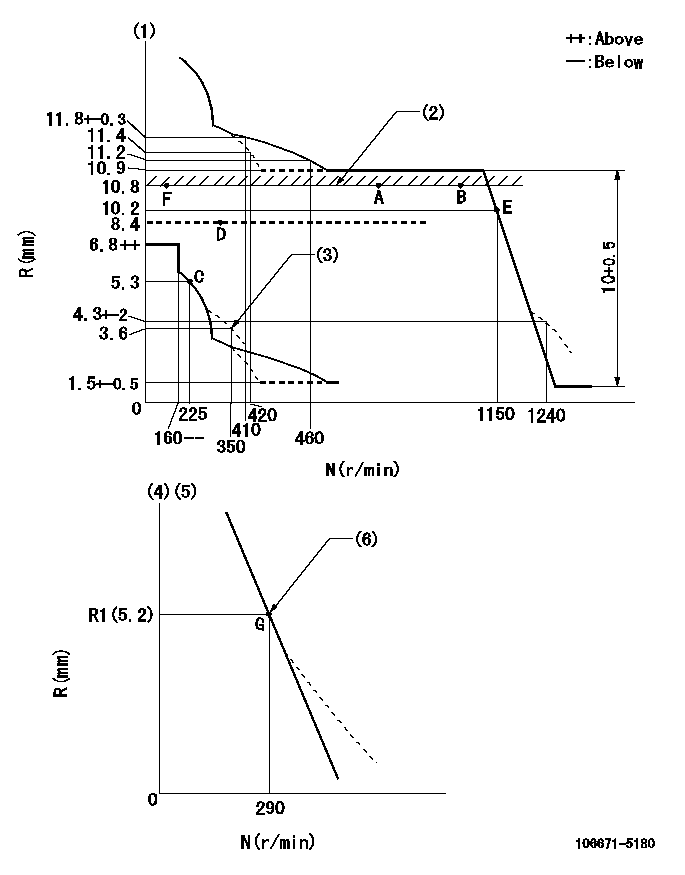
N:Pump speed
R:Rack position (mm)
(1)Tolerance for racks not indicated: +-0.05mm.
(2)Rack limit using stop lever
(3)Damper spring setting
(4)Variable speed specification: idling adjustment
(5)Fix the lever at the full-load position at delivery.
(6)Main spring setting
----------
----------
----------
----------
Speed control lever angle

F:Full speed
I:Idle
(1)Pump speed = aa
(2)Set the stopper bolt (fixed at full-load position at delivery.)
----------
aa=290r/min
----------
a=(13deg)+-5deg b=5.5deg+-5deg
----------
aa=290r/min
----------
a=(13deg)+-5deg b=5.5deg+-5deg
0000000901

F:Full load
I:Idle
(1)Stopper bolt setting
----------
----------
a=34.5deg+-3deg b=45deg+-5deg
----------
----------
a=34.5deg+-3deg b=45deg+-5deg
Stop lever angle
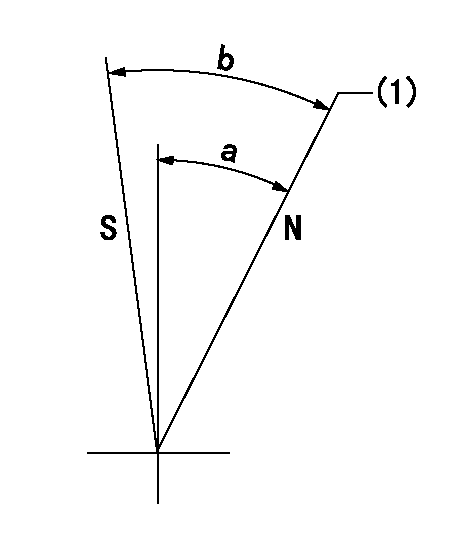
N:Pump normal
S:Stop the pump.
(1)Rack position = aa
----------
aa=10.8mm
----------
a=32deg+-5deg b=32deg+-5deg
----------
aa=10.8mm
----------
a=32deg+-5deg b=32deg+-5deg
0000001501 RACK SENSOR
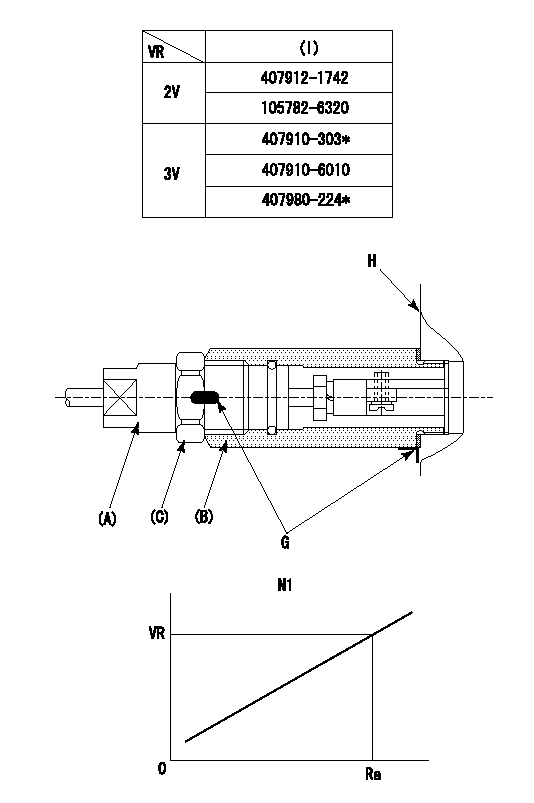
(VR) measurement voltage
(I) Part number of the control unit
(G) Apply red paint.
(H): End surface of the pump
1. Rack sensor adjustment (-0620)
(1)Fix the speed control lever at the full position
(2)Set the speed to N1 r/min.
(If the boost compensator is provided, apply boost pressure.)
(3)Adjust the bobbin (A) so that the rack sensor's output voltage is VR+-0.01.
(4)At that time, rack position must be Ra.
(5)Apply G at two places.
Connecting part between the joint (B) and the nut (F)
Connecting part between the joint (B) and the end surface of the pump (H)
----------
N1=600r/min Ra=10.8mm
----------
----------
N1=600r/min Ra=10.8mm
----------
0000001601 BCS
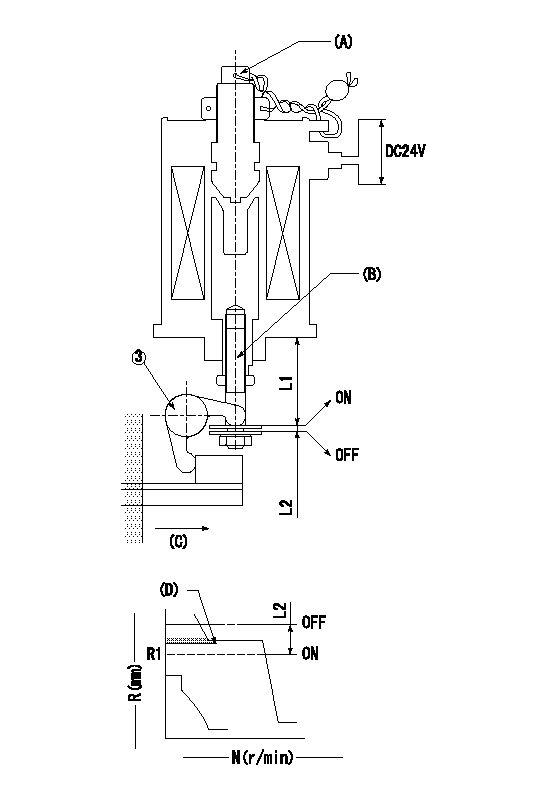
(A) Screw for precise adjustment
(B) Pre-adjustment screw
(C) Control rack, rack decrease direction
(D) Rack limit
1. Solenoid boost compensator adjustment
(1)Supply DC: V1 to the solenoid terminals and confirm solenoid operation.
(2)With the solenoid ON, calculate L1 from the value of R1. [L1 = La + (10.5 - R1) +-0.2]
(3)Adjust (B) to obtain L1.
(4)Assemble the solenoid to the governor.
(5)With the solenoid ON, readjust (B) so that R1 is within the allowance a.
(6)With the solenoid OFF, perform all governor adjustments except rack limit adjustment.
(7)Set the pump speed at N1 and turn the solenoid ON.
(8)Adjust (A) so that R1 is within the allowance range a.
(9)Set the pump speed at N1 and fix the load lever in the full position
(10)Turn the solenoid switch ON and OFF several times and confirm that the difference in rack positions is within L2.
(11)Set the rack limit.
(12)Stamp the solenoid valve.
----------
V1=24V N1=300r/min N2=0r/min R1=8.4mm a=+-0.5mm La=28mm L1=30.1+-0.2mm L2=3.5~5mm
----------
----------
V1=24V N1=300r/min N2=0r/min R1=8.4mm a=+-0.5mm La=28mm L1=30.1+-0.2mm L2=3.5~5mm
----------
Timing setting
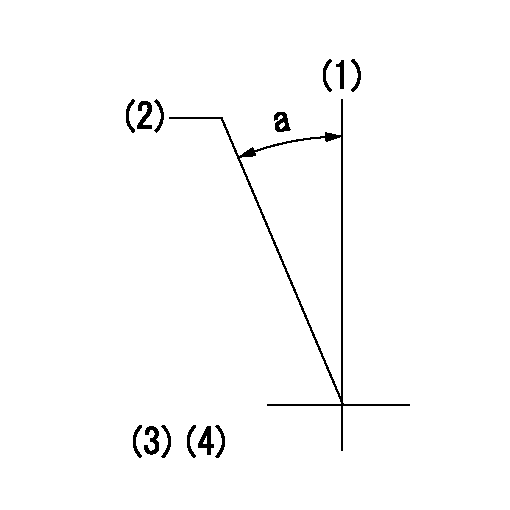
(1)Pump vertical direction
(2)Coupling's key groove position at No 1 cylinder's beginning of injection
(3)-
(4)-
----------
----------
a=(20deg)
----------
----------
a=(20deg)
Information:
ACTIVE Diagnostic Codes
Diagnostic codes are used by the PEEC III system to warn the vehicle operator of a problem and indicate to the service technician the nature of the problem. Some codes are used only to record an event, and do not indicate problems.An ACTIVE Diagnostic code represents a problem that should be investigated and corrected AS SOON AS POSSIBLE. Repairing the cause of an ACTIVE code will cause the code to be cleared from the ACTIVE Diagnostic Code screen.When an ACTIVE code is generated, the PEEC III lamp will turn ON and remain ON, blinking every five seconds. If the condition generating the fault occurs only for a brief moment, the lamp will go OFF after five seconds and the fault will be LOGGED. After a problem has been investigated, the related diagnostic code should be cleared from memory.ACTIVE codes may be viewed using either of the electronic service tools (ECAP or DDT), and may also be viewed using the cruise control switches.Using The ECAP Or DDT To Display ACTIVE Codes
A. With key OFF, install an ECAP or DDT into the PEEC III system.B. Turn key ON (engine does not need to be started to view codes).C. Refer to the Operating Manual and Special Instructions for the service tool (listed under PEEC III Service Tools) to read the code(s). On the ECAP, the display menu will direct you to the proper screen to display diagnostic messages similar to the example below.Using The Cruise Control Switches To Display ACTIVE Codes:
A. Turn key ON (engine does not need to be started to view codes).B. The PEEC III Lamp will turn ON for five seconds, blink OFF for 1/10 second, turn ON again for five seconds, then OFF for five seconds. At the end of that time, the lamp will begin to flash the first number of the two-digit code (count the flashes). After two seconds OFF, then it will flash the second digit. If two or more codes are present, they will follow the first after a few seconds and be displayed in the same manner.C. Active Diagnostic codes may be displayed at any time by using cruise control switches. With key ON or engine running, turn the cruise control ON/OFF switch to OFF, and move the SET/RESUME switch to RESUME position. Once the codes begin to flash the switch may be released. The PEEC III Lamp will flash out all the codes that are currently active, or intermittent codes that have occurred since the key was turned on.Example ECAP Screen: "Display ACTIVE Diagnostic Messages" LOGGED Diagnostic Codes
When an ECM generates a diagnostic code, it usually logs the code in permanent memory within the ECM. The time the code occurred (in hours on the internal diagnostic clock) is logged along with the code. The logged codes can then be later retrieved or erased using an ECAP or DDT service tool. They can be a valuable indicator when troubleshooting intermittent problems.PEEC III must be out of Cold Mode for at
Diagnostic codes are used by the PEEC III system to warn the vehicle operator of a problem and indicate to the service technician the nature of the problem. Some codes are used only to record an event, and do not indicate problems.An ACTIVE Diagnostic code represents a problem that should be investigated and corrected AS SOON AS POSSIBLE. Repairing the cause of an ACTIVE code will cause the code to be cleared from the ACTIVE Diagnostic Code screen.When an ACTIVE code is generated, the PEEC III lamp will turn ON and remain ON, blinking every five seconds. If the condition generating the fault occurs only for a brief moment, the lamp will go OFF after five seconds and the fault will be LOGGED. After a problem has been investigated, the related diagnostic code should be cleared from memory.ACTIVE codes may be viewed using either of the electronic service tools (ECAP or DDT), and may also be viewed using the cruise control switches.Using The ECAP Or DDT To Display ACTIVE Codes
A. With key OFF, install an ECAP or DDT into the PEEC III system.B. Turn key ON (engine does not need to be started to view codes).C. Refer to the Operating Manual and Special Instructions for the service tool (listed under PEEC III Service Tools) to read the code(s). On the ECAP, the display menu will direct you to the proper screen to display diagnostic messages similar to the example below.Using The Cruise Control Switches To Display ACTIVE Codes:
A. Turn key ON (engine does not need to be started to view codes).B. The PEEC III Lamp will turn ON for five seconds, blink OFF for 1/10 second, turn ON again for five seconds, then OFF for five seconds. At the end of that time, the lamp will begin to flash the first number of the two-digit code (count the flashes). After two seconds OFF, then it will flash the second digit. If two or more codes are present, they will follow the first after a few seconds and be displayed in the same manner.C. Active Diagnostic codes may be displayed at any time by using cruise control switches. With key ON or engine running, turn the cruise control ON/OFF switch to OFF, and move the SET/RESUME switch to RESUME position. Once the codes begin to flash the switch may be released. The PEEC III Lamp will flash out all the codes that are currently active, or intermittent codes that have occurred since the key was turned on.Example ECAP Screen: "Display ACTIVE Diagnostic Messages" LOGGED Diagnostic Codes
When an ECM generates a diagnostic code, it usually logs the code in permanent memory within the ECM. The time the code occurred (in hours on the internal diagnostic clock) is logged along with the code. The logged codes can then be later retrieved or erased using an ECAP or DDT service tool. They can be a valuable indicator when troubleshooting intermittent problems.PEEC III must be out of Cold Mode for at